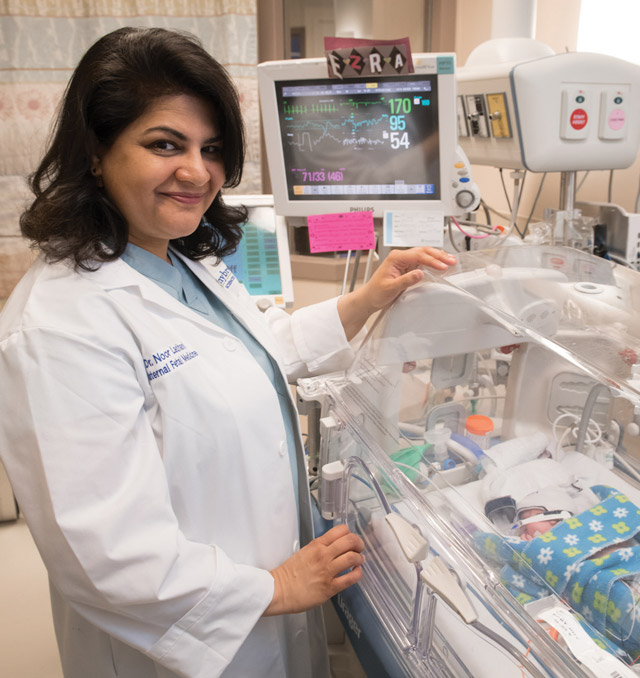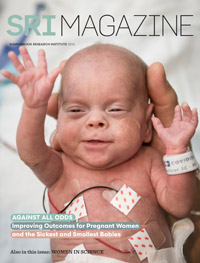Which interventions are best for extremely early preemies?

Studies seek to guide the care of babies born at the edge of viability
September 12, 2018

Dr. Noor Ladhani researches the use of obstetrical interventions on babies who are born at fewer than 26 weeks of gestation—the borderline of viability. She is studying whether use of steroids on babies born between 23 and 25 weeks’ gestation improves outcomes.
In 2009, Jennifer Lake was just past the midpoint of her pregnancy when she went into labour and gave birth at home. Her 22-week-old son was taken to St. Joseph’s Hospital in London, Ont., where he was admitted to the neonatal intensive care unit.
Doctors told her that her son likely would not survive, and if by the slimmest of chances he did, then his quality of life would be dreadful, Lake said in a 2015 article published in the National Post. She was counselled by medical staff to take him off life support, but she rejected the recommendations. Six years later, her son, Carter, despite some physical and neurological disabilities, was preparing to enter Grade 1. “He lights up my whole entire life,” Lake said in the story.
The case highlights how thorny the issues are around counselling and management of babies born extremely early. At the time of Carter’s birth, the Canadian Paediatric Society’s guidelines for managing extreme preterm birth strongly recommended that babies born at 22 weeks of gestation not receive life-saving measures, only comfort care. In 2017, the organization revised its guidelines, stating: “When an extremely preterm infant is born but no decision has been reached regarding the management plan … the infant should usually receive early intensive care until shared decision-making or further discussion with the parents can occur.”
According to Statistics Canada, about 8% of all births in the country are preterm, or before 37 weeks—the point at which fetal development is thought to be complete. Premature birth can result in difficulty breathing, bleeding in the brain and major intestinal disease; the more premature a baby is, the greater the problems are likely to be. A fetus is considered viable if it is capable of surviving outside the womb. For those born at the brink of viability—between 22 weeks and 24 weeks plus six days of gestation—survival is lower, and the odds of severe disability are high. These include intellectual disability, cerebral palsy, blindness and deafness.
The occurrence of extreme preterm birth is about 2% of early deliveries, notes Dr. Noor Ladhani, an associate scientist in the DAN Women & Babies Research Program at Sunnybrook Research Institute and a maternal-fetal medicine specialist at Sunnybrook who treats women with high-risk pregnancies. Her practice includes women who’ve had a stroke or a history of preterm birth or stillbirth, and women with either blood clots or the human immunodefi ciency virus. I meet with Ladhani to discuss her research on medical interventions performed on babies born at the borderline of viability. They are, according to her, “the most vulnerable.” A baby born at 23 weeks’ gestation, for example, typically weighs about 500 grams.
Her research aims to provide evidence that will help with decision-making in situations that are unexpected and distressing for parents, and difficult to manage medically and ethically for practitioners. The challenges are significant, Ladhani says. “Research is hard in this area because the rates [of extreme preterm birth] are low, and because every case is different. And because it’s such a stressful time for families, doing a randomized controlled trial is not feasible.”
She notes that there are studies showing the benefits of obstetric interventions used on babies who are between 28 and 30 weeks’ gestation. These include administering steroids, delivery via C-section and giving magnesium sulfate. The outcomes of these babies are also better if they are delivered at a centre with a neonatal intensive care unit. There is very little published, however, on babies born at the lower limit of viability. “Until a few years ago we weren’t even resuscitating these babies, so the data are really sparse,” says Ladhani. “In women who were at 23 weeks, we were using a ‘wait and see’ approach. It didn’t make sense because we know those interventions can improve outcomes. My interest came from seeing if those interventions would be of benefit to those babies.”
Ladhani has studied whether extremely preterm babies in the breech, or feet-first, position have improved survival if they are born via C-section. She examined records of breech births of babies who were between 23 and 25 weeks’ gestation and delivered at Sunnybrook between 2003 and 2013. She found the rate of death was about 20% lower in the babies who were delivered surgically. “There’s lots of controversy because we know that a C-section at that early stage can have dramatic effects for a woman. Women bleed more, and it affects their future pregnancies. But if we think it confers survival benefit to the baby, then we have to give a woman the choice,” says Ladhani.
She is also conducting a study on the use of steroids on babies born between 23 and 25 weeks’ gestation. Steroids generally improve outcomes for infants born prematurely by reducing the risk of respiratory distress syndrome, bleeding in the brain and damage to the intestinal tract. They have also been shown to shorten stays in the neonatal intensive care unit and improve survival. The results of the study are not yet available, but she cites a systematic review and meta-analysis by researchers at McMaster University showing that giving steroids to babies born before 24 weeks of gestation reduced the risk of death to discharge by about 50%.
As the use of life-saving measures on babies born extremely prematurely evolves and the lower limit of viability shifts, both families and care providers need guidance. To this end, Ladhani and colleagues published clinical guidelines for the management of infants born before 26 weeks’ gestation. Published in the Journal of Obstetrics and Gynaecology Canada, the guidelines summarize findings from published research in this area, like giving steroids to babies after birth and using continuous fetal monitoring. For her next project, she will interview women with a history of extreme preterm birth to understand how to improve counselling in these difficult situations. Ladhani says she is eager to learn what information they want to help them decide what to do. “Because decision-making is so important for family outcomes, and because survival—and survival without disease—is not guaranteed, we need to help families make a decision that they can live with.”
Evidence-based care for extremely early birth
The right interventions give babies at the edge of viability (defined as less than 26 weeks of gestation) the best chance of survival. Led by Dr. Noor Ladhani, researchers in maternal-fetal medicine at Sunnybrook Research Institute combed through the literature to create guidelines to help clinicians manage these complex cases. Published in 2017 in the Journal of Obstetrics and Gynaecology Canada, here are the recommendations for extreme premature birth:
- Provide women with counselling from an expert multidisciplinary team, as well as data on national and local survival rates.
- Offer women transfer to a hospital with a neonatal intensive care unit. Gestational age, estimated fetal weight and parental preferences should factor into the decision.
- Allow for first-trimester ultrasound in all pregnancies, especially when women are at risk for early delivery.
- Give women a single course of antenatal corticosteroids if delivery is expected within seven days and resuscitation is planned. When an initial course of corticosteroids is given before 25 weeks of gestation, do not give a rescue dose of corticosteroids, as there is no evidence for doing so.
- Give magnesium sulfate to babies if delivery is imminent and resuscitation is planned.
- Avoid delivery by C-section, unless required to protect the mother. If the fetus is in an abnormal position or there are other obstetric indications, then a multidisciplinary approach should be used to come to a decision that considers the outcome of both mother and baby when active care is planned.
- Use fetal monitoring during labour and delivery when planning to use life-saving measures.
- Delay cord clamping.
Ladhani’s research was supported by the DAN Women & Babies Program at Sunnybrook.



